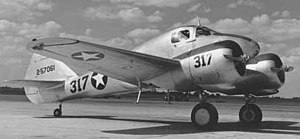Curtiss-Wright AT-9 Jeep
| AT-9 Jeep | |
|---|---|

| |
| AT-9A | |
| Role | Advanced twin-engined trainer |
| Manufacturer | Curtiss-Wright Corporation |
| First flight | 1941 |
| Primary users | United States Army Air Forces United States Air Force |
| Produced | 1941–1943 |
| Number built | 792 (including prototype and AT-9A variant) |
The Curtiss-Wright AT-9 Jeep was a twin-engined advanced trainer aircraft used by the United States during World War II to bridge the gap between single-engined trainers and twin-engined combat aircraft. The AT-9 had a low-wing cantilever monoplane configuration, retractable landing gear and was powered by two Lycoming R-680-9 radial engines.
Development
Curtiss-Wright anticipated the requirement for this type of "high-performance" aircraft and designed the Curtiss-Wright CW-25, a twin-engined trainer, which possessed the takeoff and landing characteristics of a light bomber. Using the same basic design as the larger Cessna AT-17 Bobcat, the new CW-25 was designed to be simulate the demands of multi-engined operations. The design featured a small layout, grouping two Lycoming R-680-9 radial engines forward and using a retractable tailwheel landing gear to achieve the performance necessary to meet the requirements of an advanced trainer. The single CW-25 prototype acquired for evaluation had a welded steel-tube fuselage structure with the wings, fuselage and tail unit fabric-covered.[1]
Operational history

The first prototype Model 25 flew in 1941 and the production version entered service as the AT-9 in 1942. Named the "Fledgling" by Curtiss-Wright, it commonly became known as the "Jeep" in the United States Army Air Forces (USAAF).[2] The prototype CW-25 had a fabric-covered steel tube fuselage and fabric-covered wings and tail units, but production AT-9s were of stressed metal skin construction. [1]
The AT-9 was purposely designed to be less stable and proved to be difficult to fly or land, which made it particularly suitable for teaching new pilots to cope with the demanding flight characteristics of a new generation of high-performance, multi-engined aircraft such as the Martin B-26 Marauder and Lockheed P-38 Lightning. [1] However, many pilots[who?] who have flown both the AT-9 and the P-38 have said that the Lightning should have been used instead to train pilots to fly the Jeep.[citation needed]
A total of 491 AT-9s were built before production ended and a new production run of 300 of the generally similar AT-9A commenced. [1]
Because of its difficult flying characteristics the AT-9 was not offered for sale to civilians after the war, although many non-flying examples were given to ground schools for training purposes.
Variants
- CW-25
- Prototype with fabric covered fuselage and tail surfaces
- AT-9
- Production aircraft with stressed-skin covering and two Lycoming R-680-9 radial engines, 491 built.
- AT-9A
- AT-9 with Lycoming R-680-11 radial engines and revised hydraulic system, 300 built before production ended in February 1943.
Operators
Survivors

Two AT-9s survive today with one AT-9A on permanent display at the National Museum of the United States Air Force in Dayton, Ohio. This aircraft required extensive restoration, and was the product of the museum staff incorporating two incomplete airframes together, along with parts fabricated on site. While the wreckage of an AT-9A recovered from a crash site in 2003 was turned over to the Pima Air & Space Museum for restoration, the aircraft is incomplete and will require a long and extensive restoration for display.
Specifications (AT-9)
Data from Curtiss Aircraft 1907–1947[3]
General characteristics
- Crew: two - student and instructor
Performance
- Climb to 10,000 ft (3,050 m): 8.6 min
See also
Aircraft of comparable role, configuration, and era
Related lists
References
Notes
Bibliography
- Bowers, Peter M. Curtiss Aircraft, 1907-1947. London: Putnam & Company Ltd., 1979. ISBN 0-370-10029-8.
- Mondey, David. American Aircraft of World War II (Hamlyn Concise Guide). London: Bounty Books, 2006. ISBN 978-0-7537-1461-4.
